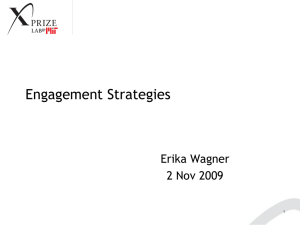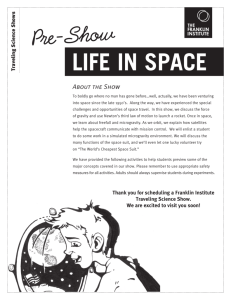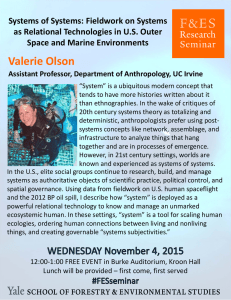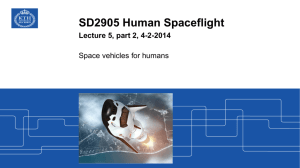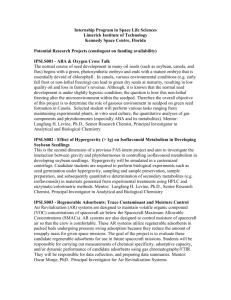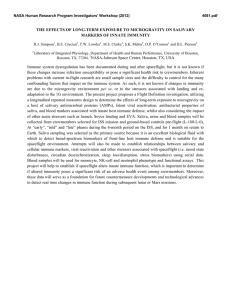Effect of Spaceflight and Spaceflight Analogues on Microbial Virulence and
advertisement
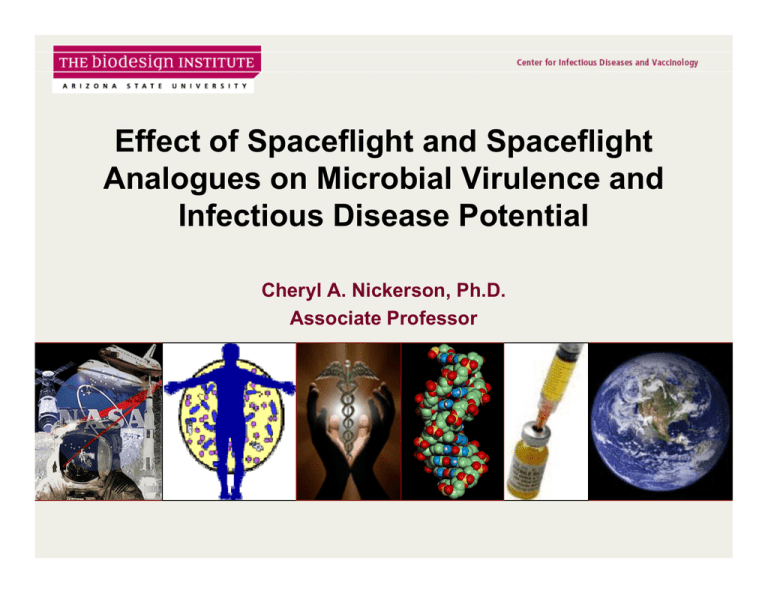
Effect of Spaceflight and Spaceflight Analogues on Microbial Virulence and Infectious Disease Potential Cheryl A. Nickerson, Ph.D. Associate Professor Goals of our Research: Mitigate risk of infectious disease to crew during human exploration of space to ensure their health, safety, and performance Critical to provide safe passage for human exploration to moon, Mars, and beyond New strategies to combat infectious disease on Earth Our Research Interests In-flight infections Risk assessment/ Countermeasures The pathogen Low fluid shear culture environment Physiologically relevant The host Medically important phenotypes not observed during conventional culture Vaccines/ Therapeutics Infectious Disease Research and Spaceflight • Major advances in our knowledge about biological systems have come by studying their responses to extreme environments - (ex. temp, pH, etc) which have led to major advances in global human health breakthroughs • Spaceflight is another extreme environment which offers tremendous potential to provide new insight into biological responses - including infectious disease • Spaceflight produces an environment that is relevant to conditions encountered by the pathogen during infection in the human host (low fluid shear) WHY STUDY PATHOGEN RESPONSE TO SPACEFLIGHT? 9 Human presence in space accompanied by presence of microbes 9 Changes to microbes during spaceflight - potential negative impact on health, safety, performance of crew 9 Certain Spaceflight conditions increase infectious disease risk: • Increased mission duration • Closed, self contained spacecraft • Reliance on regenerative life support systems • International crews • Increased number/distribution of potential pathogens • Immune system alterations • Changes in antibiotic resistance • Increased microbial virulence 9 Spaceflight/spaceflight analogue environments biologically relevant - affect microbial physiology, gene expression, pathogenesis - mechanism(s) unclear • New targets for vaccine/therapeutic development for treatment/prevention Pre-flight: Ground Based Research Our Model Intestinal Pathogen - Salmonella typhimurium • Common food-borne pathogen >2,000,000 cases annually in U.S. • A leading cause of death from foodborne illness in U.S. • Responsible for pre-flight ISS food disqualification • Gastroenteritis, secretory diarrhea in healthy individuals • Can cause serious/fatal infections in immunocompromised • Best characterized bacterial pathogen Spaceflight analogue studies indicate changes in microbial pathogen characteristics Salmonella typhimurium Virulence Gene expression * Classic virulence genes down-regulated * Ion response genes/pathways! Rotating Wall Vessel bioreactor Stress Resistance (Macrophage, acid, thermal, osmotic, oxidative) Nickerson et. al., 2000, Infect. Immun. 68:3147-3152; Wilson, et al., 2002, Proc. Natl. Acad. Sci. USA. 99:13807-13812; Wilson, et al., 2002, Appl. Environ. Microbiol. 68:5408-5416; Nickerson, et al., 2004, Microbiol Mol Biol Rev, 68:345-361. LSMMG increases Salmonella virulence 100 Percent survival LSMMG S. typhimurium 1xg 1xg 50 Mice 0 5 10 15 20 Time of Death (Days) LSMMG LSMMG (pH=3.5) S. typhimurium S. typhimurium LSMMG also increased resistance of Salmonella to osmotic and thermal stress Macrophages 10 1xg 0 20 40 Time (minutes) cell--associated Number of cell bacteria per well Acid Stress Percent survival (log10) 100 60 106 105 104 103 20 min LSMMG 1xg Nickerson et. al., 2000, Infect. Immun. 68:3147-3152: Wilson et al., 2002, Applied and Environ Microbiol. S. typhimurium genome The S. typhimurium LSMMG regulon 163 genes differentially regulated by LSMMG Propanediol utilization Molydopterin binding protein Prolyl isomerase Type III secretion Amino acid/dipeptide acid/dipeptide transport Ribosomal protein subunits LPS side chain synthesis FeFe-S cluster formation ABC transport apparatus Stationary phase induced Transcriptional regulator Other or unknown function 1xg LSMMG Classic virulence genes down-regulated in response to LSMMG Nickerson et. al., 2000, Infect. Immun. 68:3147-3152; Wilson et. al., 2002, PNAS, 99(21): 13807 13812 Phenotypic Verification of Microarray Results: LPS profiles of LSMMG- and 1xg-grown Salmonella 1xg LSMMG LPS quantitation ratio (LSMMG/1xg) 0.66 +/- 0.03 Wilson et. al., 2002, PNAS, 99(21): 13807-13812 Fur is a Regulator of the LSMMG response in Salmonella WT % survival (log10) 100 Fur - Global regulatory LSMMG 10 1xg protein senses Fe2+ levels, important for Salmonella virulence 1 0 min 30 min 60 min LSMMG 1xg fur % survival (log10) 100 LSMMG 10 1xg 1 0 min 30 min LSMMG-induced acid stress resistance is not observed in S. typhimurium fur mutant 60 min Time Wilson et. al., 2002, PNAS, 99(21): 13807-13812 Lessons from Ground Based Studies • • • Microorganisms change genotypic and phenotypic characteristics, including virulence The cause is due to fluid shear forces on the cell surface Ion types and concentrations may regulate this microbial response Importance for both Earth-based and Spaceflight studies for countermeasures for infectious disease MICROBE launches on board Shuttle Atlantis September 9, 2006 Astronaut Heidi Stefanyshyn-Piper activates MICROBE on orbit MDRV launches on board Shuttle Endeavour March 11, 2008 Commander Dom Gorie activates MDRV on orbit MICROBE Experimental Design Effect of Spaceflight on Microbial Gene Expression and Virulence SPECIFIC AIMS: 1) Microarray and proteomic- mediated gene expression profiling of S. typhimurium, P. aeruginosa, and C. albicans, in response to spaceflight, as compared to normal gravity controls. 2) Determination of the effect of spaceflight on the virulence potential of these microorganisms immediately following their return from spaceflight. * Better understand how microgravity affects genes, and may gain insight into the genetic basis of how humans respond to microgravity Model Microbes Chosen for this Study: S. Typhimurium, P. aeruginosa, and C. albicans Selection Criteria: •Benchmark microbes for biological applications •Isolated aboard Space Shuttle, Mir Space Station, ISS, or their crew •High risk potential for isolation aboard spacecraft •May appear as a result of use of regenerative ALSS •Availability of microarrays •Previous ground-based studies demonstrating effect of LSMMG on gene expression and virulence MICROBE Shuttle Atlantis, STS-115, launch Sept 9, 2006 Results: Gene expression Spaceflight Globally Alters Microbial Gene Expression (167 genes) Ion response pathways Identification of global molecular regulator (“master switch”) of spaceflight induced cellular responses! Disease potential Spaceflight Alters Microbial Virulence (Increased disease potential for Salmonella in rich media) In-flight hardware Cellular morphology Spaceflight alters microbial morphology (biofilm production) * Synchronous ground controls maintained under identical conditions as those on-board Shuttle ground and in-flight hardware loaded with same sample. Wilson et al., 2007, Proc. Natl. Acad. Sci. USA. 104(41):16299-304 Experimental hardware used in flight and in synchronous ground controls at Kennedy Space Center (KSC) flight ground *Synchronous ground controls maintained under identical conditions as those onboard Shuttle - ground and in-flight hardware loaded with same inoculum. Wilson et al., 2007, Proc. Natl. Acad. Sci. USA. 104(41):16299-304 Spaceflight alters Salmonella morphology In-flight grown S. typhimurium showing presence of unidentified extracellular matrix material Synchronous ground-grown S. typhimurium controls Wilson et al., 2007, Proc. Natl. Acad. Sci. USA. 104(41):16299-304 Spaceflight Increases Salmonella Virulence in Murine Model of Infection • Decreased time to death • Increased percent mortality • Decreased LD50 value (cfu) Flight Ground Wilson et al., 2007, Proc. Natl. Acad. Sci. USA. 104(41):16299-304 Spaceflight globally alters Salmonella gene expression 4500000 0 500000 4000000 • Protein secretion Salmonella enterica serovar Typhimurium genome 3500000 • Outer membrane proteins 1000000 • Iron metabolism and storage • Ion response pathways 4,857 kb • Plasmid transfer functions 1500000 3000000 • Energy and metabolism • Ribosomal proteins 2500000 2000000 • Small regulatory RNAs • Biofilm formation Global Proteomic Profiling (MudPIT) identifies 73 proteins differentially regulated by spaceflight • Transcriptional regulators • Unknown function Hfq - Master molecular regulator identified Wilson et al., 2007, Proc. Natl. Acad. Sci. USA. 104(41):16299-304 Hfq involvement confirmed with a ground-based spaceflight analogue model (RWV) 14 13 12 11 10 9 8 7 6 5 4 3 2 1 0 Macrophage survival 6 5 Fold intracellular bacterial replication Acid survival ratio (1xg/LSMMG) Acid Stress 4 3 2 1 0 WT WT hfq Δhfq hfq 3'Cm hfq 3'Cm hfq 3Cm g hfq 3Cm L delta hfq g delta hfq L invA invA Fur regulates LSMMG acid stress resistance; Hfq regulates Fur 1xg LSMMG 1xg hfq 3'Cm LSMMG Δhfq Spaceflight data confirmed with groundbased model Wilson et. al., 2007, Proc. Natl. Acad. Sci. USA. 104(41):16299-16304. The MDRV Flight Experiment STS-123, March, 2008 A follow-up to MICROBE: SPECIFIC AIMS: • Independent validation of the effect of spaceflight on Salmonella virulence in rich and minimal media • Determine if modulation of different ion concentrations can be used as novel way to counteract or block spaceflight-associated increase in disease-causing potential observed in Salmonella in rich media • Determine common spaceflight responses that are conserved/shared between different pathogenic microbes MDRV Shuttle Endeavour, STS-123, launch March, 2008 Experiment Design: Disease potential • Independent validation of STS-115 results • Test effect of media ion composition Media Composition In-flight hardware * Common response conserved in other pathogens? Synchronous ground controls maintained under identical conditions as those on-board Shuttle - ground and in-flight hardware loaded with same sample. Manuscript Submitted Lessons Learned from Flight Studies • Spaceflight alters microbial genotypic and phenotypic characteristics, including virulence, in novel ways not observed using traditional experimental approaches • Gene regulatory proteins identified during spaceflight can be targeted for vaccine development • Modulation of different ion concentrations can be used to counteract/inhibit the enhanced virulence of pathogens in spaceflight Importance for both Earth-based and spaceflight studies for new strategies to combat infectious disease Acknowledgements Arizona State University James Wilson Laura Quick Emily Richter Denise Fernandez Lokesh Joshi Phillip Stafford Miti Shah Michelle Kilcoyne Joe Wang Marc Porter Randy Nelson Roy Curtiss University of Colorado HSC Michael Schurr NASA Johnson Space Center Mark Ott Duane Pierson Mayra Nelman-Gonzalez Don Tucker Scott Smith Sarah Zwart Neal Pellis Dennis Grounds Heidi Stefanyshyn-Piper and the crew of STS-115 Commander Dom Gorie and the crew of STS-123 Oklahoma City University Kent Buchanan Tulane University HSC Lisa Morici Kerstin Honer zu Bentrup NASA HQ Jacob Cohen Mark Uhran NASA ARC Steve Hing Macarena Parra Paula Dumars Gary Jahns Sid Sun Russ Kerschmann Kennedy Space Center Ramona Bober Kelly Norwood Luke Catella Jennifer Devich Ashleigh Ruggles Joseph Benjamin Amber DeBaca Satro Narayan BioServe Carla Goulart Mark Rupert Alex Hoehn Louis Stodieck University of Arizona George Tsaprailis
